Iraq. Maryam al-Adhra Monastery. An Open Space.
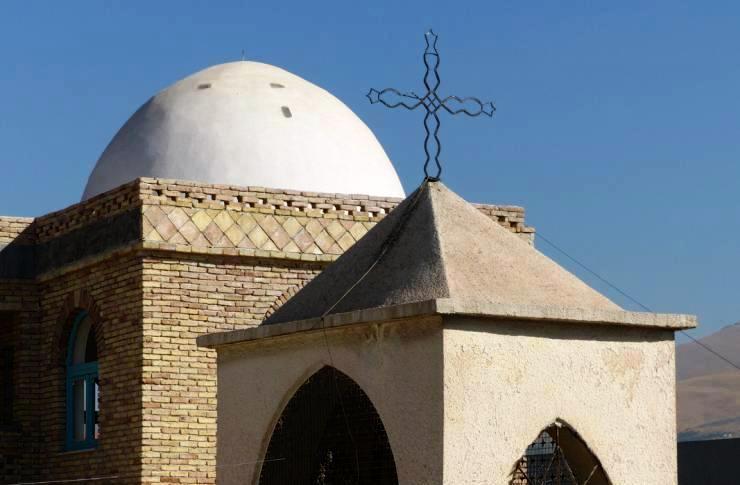
A visit to Maryam al-Adhra monastery; a place of dialogue and peace in Iraqi Kurdistan.
It can only be seen at the last moment and only if you are looking for it: in the heart of Sulaymaniyya, among narrow streets and pedestrian alleys, small shops and tea rooms, finally a large building appears around a corner, not very dissimilar from those all around, and a small bell tower. It is precisely the latter that indicates that we have arrived. Unlike most of the monasteries that scale mountains, that of Deir Maryam al-Adhra (Virgin Mary) must literally be found in the oldest part of the second largest city in Iraqi Kurdistan: two million inhabitants, almost all Muslims and a small group of Christians
of various denominations.
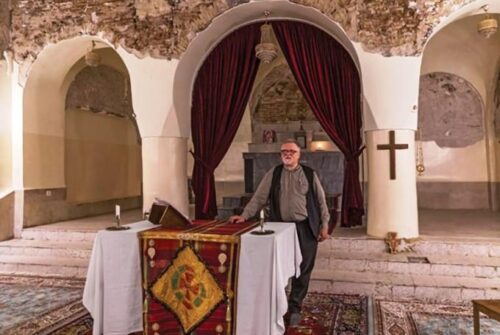
Father Jens in the chapel. The monastery of Maryam al-Adhra was founded 11 years ago from what remained of an abandoned parish.
The monastery of Maryam al-Adhra was founded 11 years ago from what remained of an abandoned parish. With a double root: the one that binds it to this territory and to the history of an ancient Christianity of which, however, few traces remain; and the one that connects it to the experience of the al-Khalil community and the Mar Musa monastery in Syria founded by Father Paolo Dall’Oglio, the Italian Jesuit kidnapped on July 29, 2013, in Raqqa.
Father Jens and Sister Friederike are today the religious personnel who carry on this experience of dialogue and peace. He had left overland for Japan. Once he arrived in Syria, they took him to the monastery of Mar Musa. “I remember it as if it were yesterday – he says – as I was leaving, Father Paolo greeted me saying: ‘I’m not saying goodbye, because tomorrow you will return’. I found it a bit strange. At that time, I was not even baptized and was attracted by the Japanese world. Then I actually went back several times to Mar Musa and for longer and longer periods, until I spent a whole year there as a volunteer. At that time everything seemed too good to me: the place, the meetings, the possibility of speaking different languages every day with different people. I was experiencing a sort of cultural hyperventilation. This is why I decided that I had to go back to Switzerland to distance myself a bit from that experience that so excited me and to be able to reflect more ‘coldly’. In the end, I decided to ask to be part of the community”.
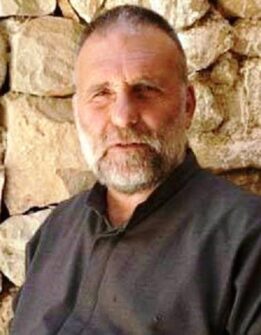
Father Paolo Dall’Oglio, the Italian Jesuit kidnapped on July 29, 2013, in Raqqa in Syria.
In 1996, Jens was baptized and in 2000 he entered the community. It was he who initiated the experience of Deir Maryam al-Adhra in Sulaymaniyya, at the end of 2011 and at the invitation of Monsignor Louis Sako, then Archbishop of Kirkuk and now Patriarch of Babylon of the Chaldeans, who had asked Father Paul to also initiate there a Christian presence in dialogue with Islam in the style of Mar Musa.
Sister Friederike, on the other hand, arrived here in 2013. She, too, embarked on a journey that started from afar, in every sense. A German, she worked in the theatre and in mime and was particularly fascinated by Sufi spirituality: “In my prayers, I saw a monastery in the desert, I felt it was calling me… I knew about Tibhirine’s experience and I understood that it was just that kind of spirituality that I was looking for. I had a very strong image. And when I came across Mar Musa, I understood that this was where I belonged”.
Friederike went there for the first time in 2008 and stayed for five weeks. “Father Paolo – she recalls – invited me to share some moments of the community. Then I went to the monastery of Mar Elian, in the city of Qaryatayn, and I felt that this was just the kind of spirituality I was looking for”. From there, Friederike embarked on the entire journey that would lead her to becoming a nun in the al-Khalil monastic community, which today has eight men and women religious with perpetual vows, a novice and a couple of postulants divided into four monasteries: Mar Musa and Mar Elian in Syria, Maryam al-Adhra in Iraqi Kurdistan, and San Salvatore a Cori, in the province of Latina in Italy.
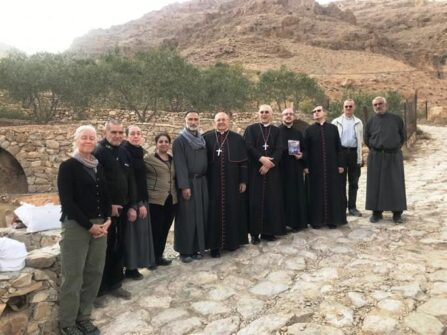
Cardinal Leonardo Sandri and Cardinal Mario Zenari visiting Deir Mar Musa al-Habashi. The first on the left Sister Friederike.
“In 2012 –Sister Friederike continues – the presence in Syria had become too dangerous due to the advance of the Islamic State. So, we decided to come here to Sulaymaniyya”.
The following years are strewn with tragedies: in 2013 Father Paolo was kidnapped and he has not been heard of since; in 2015 also Father Jacques Mourad, rector of the Mar Elian monastery, was kidnapped for five months by jihadist militiamen, first alone then with 150 other Christians from the city of Qaryatayn; in 2016, even the monastery, which houses the relics of Saint Elias (miraculously saved), was attacked and partially destroyed. Last February, Father Mourad was elected the new Syro-Catholic archbishop of Homs, the ancient local episcopal see.
In all this long period of violence and suffering, only the Sulaymaniyya monastery has remained a place of relative peace even though it has not escaped the consequences of the war; in fact, millions of refugees fleeing both from southern Iraq and from Syria have poured into all of Iraqi Kurdistan. And so, the monastery of Deir Maryam al-Adhra also becomes a base and a refuge for both the non-Syrian monks of the community and for refugees.
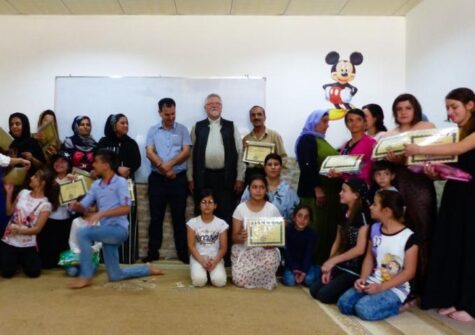
Christians are a very small minority of about 2,300 people out of a population of 2 million inhabitants.
From 2014 to 2017, in fact, the community worked very hard to offer hospitality and support to about 50 Christian families (250 people in all) fleeing the Nineveh plain, invaded by Isis. “We hosted them for three years in the monastery, in three houses and in some prefabricated buildings. Today, a third of them have managed to flee abroad, many have returned home, while some have remained mainly in the suburbs of Erbil”, Father Jens explains. “Even today – adds Sister Friederike – we still try to assist in various ways the refugees and displaced persons of various origins who are found in the Sulaymaniyya area. Not only that though. The monastery is currently, above all, an open space for dialogue with local society, especially with young people and adults who attend the library and the many courses we organize: languages, journalism, photography, theatre, professional training, but also workshops and conferences in particular on themes of dialogue,
peace and coexistence”.
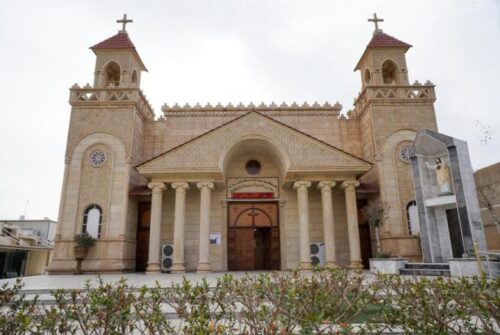
The Chaldean Cathedral of the Sacred Heart in Kirkuk. © Pascal Maguesyan
“Christians – Father Jens explains – are a very small minority of about 2,300 people out of a population of 2 million inhabitants. They are basically divided into three groups. The first is made up of 500-600 people who have lived here for three generations, speak Kurdish and dress like Kurds; the majority are Chaldeans, but there are also some Assyrians and two Armenian families. A second group is made up of 400-500 people who fled Iraq after the 2003 violence; these are mainly Chaldeans and Syro-Catholics. Finally, the third group is made up of Christians who fled ISIS attacks in 2014; they number about 400 and some have found work here and do not think of returning to their homelands because they have lost everything. Then there are several foreigners who are Christians, but not very practising: about twenty participate in the festive Mass celebrated in English”.
In the city there is also a Chaldean parish, a Coptic church and four groups of evangelical Protestants; in the neighbourhood of the monastery there were also Jews and still today there are some women of Jewish origin who married Muslim men.
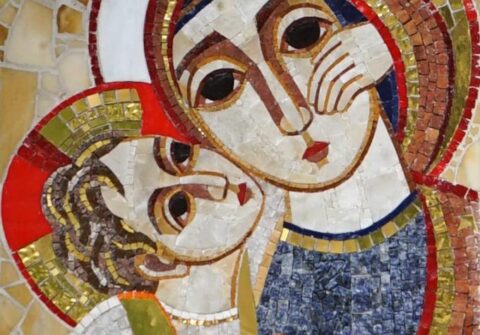
The heart of Sulaymaniyya is, in a small way, the mirror of a country where a great variety of languages are spoken (Kurdish, Arabic, Neo-Aramaic, Turcoman, etc.) and where there are various ethnic-religious components: Sunni Muslims and Shiites in their various streams and with a deep-rooted Sufi tradition; Christians belonging to the Chaldean, Syro-Catholic, Syro-Orthodox and Protestant Churches; but also, Zoroastrians, Yazidis, Manichaeans, Kakai. In short, as often happens in the Middle East, even in this corner of Iraqi Kurdistan, ancient and complex pieces of history are condensed, showing many cracks and great efforts, but also a very special charm.Even the church of the monastery tells a troubled story. Inspired by a similar building in Sanandaj, in Iranian Kurdistan, it was built by Christians from Iran in 1862; it is one of the oldest buildings in Sulaymaniyya.
Father Jens is well aware of the difficulties but looks forward with confidence. And he shows us two ‘details’ which, as always, mean a lot: a traditional cloth on the altar made by a woman who wove a similar one for the Pope on his visit to Iraq in March 2021; and a small image of Our Lady in a niche in the courtyard. After all, the whole history of Christians of these lands – and also of this same monastery – is studded with many miracles great and small.
Anna Pozzi/MM



